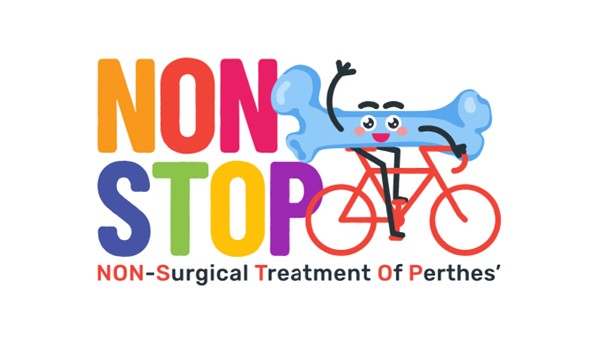
What is Perthes’ disease?
Perthes’ Disease is a rare condition that affects the developing femoral head (the “ball” of the “ball and socket” hip joint) of a child due to poor blood supply. In this condition, the blood supply to the femoral head is disrupted and this leads to joint deformity. The destruction typically causes the femoral head to flatten and not fit well in the acetabulum (the “socket” of the hip joint). This in turn can cause significant pain for children with Perthes’ disease and limit their activity levels significantly.

Perthes’ disease affects around 1 in 1000 children in their lifetime and the north of England has some of the highest rates in the world. The cause is unknown, and there is currently no evidence stating whether surgical or non-surgical treatment is best for children with Perthes’ disease.
I see relatively high numbers of children with this condition in my clinical practice, and the impact that it has on their quality of life led me to seek funding for the NON-STOP project.
What is the NON-STOP project?
The NON-STOP (NON-Surgical Treatment Of Perthes’) project is a Clinical Doctoral Research Fellowship funded by Health Education England and the National Institute for Health and Care Research (NIHR). It is a PhD fellowship in which I have, along with amazing support both clinically and academically, developed a non-surgical digital self-management intervention (an app) for children with Perthes’ disease.
The methods used to design, develop and test this app have been used in many intervention development studies, and a mixed-methods approach has been used. This has meant that the results of each smaller study within the project have directed the next stage of the app development. There are three key studies within the NON-STOP project.
The first study was a qualitative study to try and understand what the experiences of care were for those most affected by Perthes’ disease. In this study, I interviewed children as young as six years old and asked them about what they had experienced in terms of clinical care and support for their Perthes’ disease. I also asked them what they thought about an app to help them self-manage their condition. I asked similar questions to families and clinicians who care for these children. Their answers shaped the design of the app and will be imperative to the final study of the project. You can read the full paper for this study here.

The second study in the project looked to develop what went into the intervention. To do this the team carried out a Delphi study, which is a study that seeks the opinions of experts in a chosen field and measures how much they agree with each other about certain topics. In this Delphi study, I asked participants to vote on how much they agreed/disagreed with treatment options for children with Perthes’ disease as well as potential advice and support that could be given to them and their families. This is a commonly used method, particularly when there is not a wealth of evidence to direct treatment. The results of this study have been written up and submitted for publication, once published, it will be shared on the social media links below. This study formed the majority of the content for the self-management intervention.
The final study in this project involved the practical design and development of the NON-STOP app as well as the testing study. The app is designed, and ready for testing, which is due to start this year. In this study, a small number of children with Perthes’ disease and their families will use the NON-STOP app for six weeks. After using the app, a small number of those children and families will come to take part in a focus group where they’ll be asked about their experiences of using the NON-STOP app. The results of the app usage as well as the focus groups will be used to understand whether the NON-STOP app is suitable for further testing/implementation in the patient population.
Who helped?
The NON-STOP project has been supported by an amazing team of supervisors providing support in a clinical and academic sense. Whilst this is a personal PhD project, there’s no way I could have got this far without the support I’ve had. With that in mind, it’s important to mention the people who have helped the most, the patients and the families! Children with Perthes’ disease and their families have been involved in the NON-STOP project since its inception. They even designed my awesome logo with Bobby the bone! Their input throughout the project has meant that the questions I ask are the right ones, the questions that are important to them as the people living with and caring for those with Perthes’ disease. Thank you to every child/family that has taken the time to be involved.

What next?
The next step is to finish the project by testing the NON-STOP app. After that, I’ll be working with other specialists interested in Perthes’ disease to answer more of the important questions we have about the condition. The most important question to answer is whether surgery or non-surgical treatment is the best thing to do for these children. The NON-STOP project has been completed to inform the non-surgical arm of that trial and I’m looking forward to being involved in the study.
You can find out more about the NON-STOP project here or by checking out my social media page on X (Twitter) here.
Comments